Swedish Volunteers in the German Wehrmacht in WWII
During the Second World War Sweden was a neutral country with a relativelystrong pro-Allied sentiment. The last major fighting Sweden took part in wasduring the Napoleonic Wars. When the Soviet Union invaded Finland in1939 though, at least 10,000 men volunteered for service with the Finnishforces to fight against the Soviets. This number is especially significantbecause there were approximately 6.5 million people living in all ofSweden at the time. Sweden and Finland are both Northern Europeancountries and had much in common, therefore, when the Soviets invaded,many Swedes felt compelled to join the Finnish Forces. Because Sweden was a strict neutral during WWII, other than during the shortexperience of the Winter War in 1939, it did not openly allow forrecruitment into foreign armies. When Germany invaded theSoviet Union in 1941 its sentiments changed very little, although the Finnswere allowed to garner volunteers once again. Approximately1,500 Swedes volunteers for service with Finland between 1941 and 1944. Before Germany invaded the Soviet Union, very few if any Swedes servedwith the Germans, although at least one Swedish volunteer was listed asserving with the 5.SS-Panzer-Division Wiking.When Germany invaded the Soviet Union, Swedish volunteers for theGerman Wehrmacht was gathered either through the German Legation in Stockholmor through the Auslands Organization, both via Norway. Swedish approval ofrecruitment was still not official after the invasion of the Soviet Unionthough, and the volunteer operations were very much clandestine affairs.In total between 130 and 300 Swedes are thought to have servedin the German Wehrmacht. David Littlejohn lists the number of Swedishvolunteers at 130 in volume 3 of “Foreign Legions of the Third Reich”, 150volunteers are listed according to Swiss Dr. Franz Riedweg – the head ofGermanic Volunteer recruiting, 175 volunteersare listed by H. Picker in “Hitler’s Table Talk”, and 315 volunteers are listed by Gottlob Berger in an unpublished biography. 300 is the generally accepted number of volunteers in the German Wehrmacht, but approximately 30 to 45Swedes were killed in WWII under Axis control with 130 Swedish volunteers surviving the war, according to Lennert Westberg, which would, therefore, place the actual number of volunteers at about 175. 11 Swedes are said to have gone to the SS Officers school at Bad-Tolz, and Swedes also are known to have fought in theBattle of Berlin in April of 1945 while serving in the Nordland Division. The vast majority of Swedes served in the ranks of the Waffen-SS, but never in a national unit or legion like many other ethnicgroups. Most Swedes were scattered within different Waffen-SS units and formations. The 5.SS-Panzer-Division Wiking, 11.SS-Panzergrenadier-Freiwilligen-Division Nordland,and the 23.SS-Freiwilligen-Panzergrenadier-DivisionNederland are all known to have had Swedes in their ranks. At least one small unit, Panzergrenadier-Kompanie 3 -Panzer-Aufkläkrung-Abteilung 11 – 11.SS-Freiwilligen-Panzergrenadier-DivisionNordland, (3rd Company of the Armored Recon Battalion of the 11th SSVolunteer Armored Infantry Division Nordland), was composed of a large number of Swedes. In fact, Panzergrenadier-Komapanie 3was given the title Swedenzug as a result of the number of Swedes in its ranks. The Swedish volunteers served in the4.Zug of Panzergrenadier-Kompanie 3. Order of battle of the SS-Panzer-Aufklärung-Abteilung 11 Kommandeur: SS-Hstf Rudolf Saalbach Authorized strength of the Abteilung: 800
Späh-Kompanie 2: (Ostf. Heckmueller) Panzergrenadier-Kompanie 3 “Swedenzug”: (Ostf. Kaiser, Ostf. Pehrsson, Ostf. Ahrens, Ostf. Pehrsson) Panzergrenadier-Kompanie 4: (Ostf. Viehmann) schwere-Kompanie 5: (Ostf. Schmidt) Source: Lennart Westberg, Die schwedischen Freiwilligen der Waffen-SS 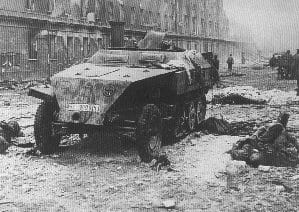 This well-known photo of a blown-up armored car in Berlin was actually one ofthe Schwedish Kompanie’s vehicles in the Nordland Division. It could havebeen company commander Pehrssons command vehicle that was shot up on theFriedrichstrasse just south of the Hitler Chancellery on the 1st ofMay 1945. The fallen Unterscharführern to the right of the armored caris in that case identical with the driver inthe car, Ragnar Johansson from Stockholm, that was killed by a Russianhand-grenade. It’s most likely that the armored car had participated inthe attempt to break out of the city on the night to the 2nd of May. The picture was taken by the Russian reporter Mark Redkin.At a picture reconstruction, at place in Berlin, the researcher LennartWestberg positioned the place for thephoto to be Friedrichstrasse 107 with the walls of the guardhouse in thebackground, 200m north of the river Spree. This well-known photo of a blown-up armored car in Berlin was actually one ofthe Schwedish Kompanie’s vehicles in the Nordland Division. It could havebeen company commander Pehrssons command vehicle that was shot up on theFriedrichstrasse just south of the Hitler Chancellery on the 1st ofMay 1945. The fallen Unterscharführern to the right of the armored caris in that case identical with the driver inthe car, Ragnar Johansson from Stockholm, that was killed by a Russianhand-grenade. It’s most likely that the armored car had participated inthe attempt to break out of the city on the night to the 2nd of May. The picture was taken by the Russian reporter Mark Redkin.At a picture reconstruction, at place in Berlin, the researcher LennartWestberg positioned the place for thephoto to be Friedrichstrasse 107 with the walls of the guardhouse in thebackground, 200m north of the river Spree.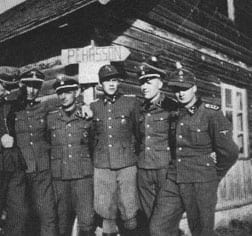 Six Swedish officers in the Waffen-SS at the Narvafront, spring 1944. Fromleft to right: Gösta B, a Kriegsberichter,Hans-Capsar Krueger, a Kriegsberichter; Hans-Gösta Pehrsson,a company commander in the SS-division Nordland, Carl Svensson,another Kriegsberichter, and Torkel Tillman, killed in action on the 26th ofJune 1944 in Normandy. Behind the camera is Rune Ahlgren, killed in action onthe 30th of October, 1944 at Preekuln, Latvia as a platooncommander in SS-division Nordland. Six Swedish officers in the Waffen-SS at the Narvafront, spring 1944. Fromleft to right: Gösta B, a Kriegsberichter,Hans-Capsar Krueger, a Kriegsberichter; Hans-Gösta Pehrsson,a company commander in the SS-division Nordland, Carl Svensson,another Kriegsberichter, and Torkel Tillman, killed in action on the 26th ofJune 1944 in Normandy. Behind the camera is Rune Ahlgren, killed in action onthe 30th of October, 1944 at Preekuln, Latvia as a platooncommander in SS-division Nordland.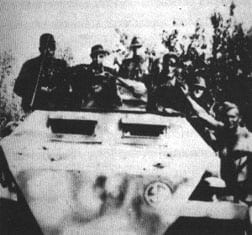 Armored Car from SS-Division “Nordland” with Swedish volunteers in Kurland,1944 or by the Odenfont, 1945. The third man from the right is sergeant RagnarJohansson from the Swedish “Skaraborgs” regiment in Skövde,Sweden. He fell on the May 2nd, 1945, thelast day of the Battles for Berlin. Next to him standsthe Stockholmer, Alfons Wahlberg, who was captured byRussian forces at Reinickendorf outside Berlin on the 21st of April, 1945. Hereturned to Sweden in 1947. Armored Car from SS-Division “Nordland” with Swedish volunteers in Kurland,1944 or by the Odenfont, 1945. The third man from the right is sergeant RagnarJohansson from the Swedish “Skaraborgs” regiment in Skövde,Sweden. He fell on the May 2nd, 1945, thelast day of the Battles for Berlin. Next to him standsthe Stockholmer, Alfons Wahlberg, who was captured byRussian forces at Reinickendorf outside Berlin on the 21st of April, 1945. Hereturned to Sweden in 1947.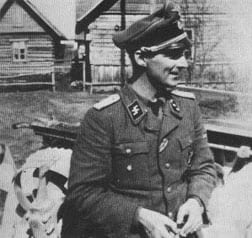 Volunteer Hans-Gösta Pehrsson, from Karlskrona (city in south-easternSweden). In this picture as SS-Hauptsurmführer, he volunteered for theWaffen-SS (fought with SS-Freiw.Pz-Gren.Wiking in the Frikorps Danmark in September 1941, became NCO after battles near lake Ilmen south ofNovgorod in 1941-42. Went through the Waffen-SS war school 1943. He becamecommander of an armored car company in SS-Division Nordland during thebattles in Estland, Lettland, and Pommerania (Estonia and Latvia) in 1944-1945.He became stf. Batallion commander and section chief in divisionNordland’s staff in April 1945. He was captured by the Russians duringthe final Battle of Berlin but managed to escape in the summer of 1945. Inthe picture from the Narvafront, Pehrsson is carrying a row of decorations;EK, Nahkampfspange in Silber (Close-combat badge in silver) andEherenblattspange des Deutschen Heeres. He died 1974, 64 years old. Volunteer Hans-Gösta Pehrsson, from Karlskrona (city in south-easternSweden). In this picture as SS-Hauptsurmführer, he volunteered for theWaffen-SS (fought with SS-Freiw.Pz-Gren.Wiking in the Frikorps Danmark in September 1941, became NCO after battles near lake Ilmen south ofNovgorod in 1941-42. Went through the Waffen-SS war school 1943. He becamecommander of an armored car company in SS-Division Nordland during thebattles in Estland, Lettland, and Pommerania (Estonia and Latvia) in 1944-1945.He became stf. Batallion commander and section chief in divisionNordland’s staff in April 1945. He was captured by the Russians duringthe final Battle of Berlin but managed to escape in the summer of 1945. Inthe picture from the Narvafront, Pehrsson is carrying a row of decorations;EK, Nahkampfspange in Silber (Close-combat badge in silver) andEherenblattspange des Deutschen Heeres. He died 1974, 64 years old.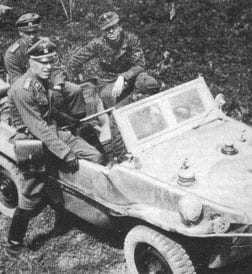 SS-Untersturmführer Carl Svenssonstanding to the left. He was working for the Swedish Navy 1941 before hewent over to German service as an anti-aircraft instructor in the Waffen-SS. Hewent to the Waffen-SS war school (Junkerschule) at Bad Tölz in 1942 and served as a Kriegsberichter at Leningrad, in the Balkans, Normandy, Arnehm and on then on the Rhine-front(?) before he returned to Sweden in 1945. SS-Untersturmführer Carl Svenssonstanding to the left. He was working for the Swedish Navy 1941 before hewent over to German service as an anti-aircraft instructor in the Waffen-SS. Hewent to the Waffen-SS war school (Junkerschule) at Bad Tölz in 1942 and served as a Kriegsberichter at Leningrad, in the Balkans, Normandy, Arnehm and on then on the Rhine-front(?) before he returned to Sweden in 1945. |
